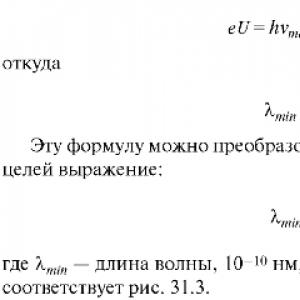How does a sound wave travel? How does sound travel through space? Elastic solids
We perceive sounds at a distance from their sources. Usually sound reaches us through the air. Air is an elastic medium that transmits sound.
If the sound transmission medium is removed between the source and the receiver, the sound will not propagate and, therefore, the receiver will not perceive it. Let's demonstrate this experimentally.
Let's place an alarm clock under the bell of the air pump (Fig. 80). As long as there is air in the bell, the sound of the bell can be heard clearly. As the air is pumped out from under the bell, the sound gradually weakens and finally becomes inaudible. Without a transmission medium, the vibrations of the bell plate cannot travel, and the sound does not reach our ear. Let's let air under the bell and hear the ringing again.
Rice. 80. Experiment proving that sound does not propagate in space where there is no material medium
Elastic substances conduct sounds well, such as metals, wood, liquids, and gases.
Let's put a pocket watch on one end of a wooden board, and move to the other end. Putting your ear to the board, you can hear the clock ticking.
Tie a string to a metal spoon. Place the end of the string to your ear. When you hit the spoon, you will hear a strong sound. We will hear an even stronger sound if we replace the string with wire.
Soft and porous bodies are poor conductors of sound. To protect any room from the penetration of extraneous sounds, the walls, floor and ceiling are laid with layers of sound-absorbing materials. Felt, pressed cork, porous stones, and various synthetic materials (for example, polystyrene foam) made from foamed polymers are used as interlayers. The sound in such layers quickly fades.
Liquids conduct sound well. Fish, for example, are good at hearing footsteps and voices on the shore; this is known to experienced fishermen.
So, sound propagates in any elastic medium - solid, liquid and gaseous, but cannot propagate in space where there is no substance.
The oscillations of the source create an elastic wave of sound frequency in its environment. The wave, reaching the ear, affects the eardrum, causing it to vibrate at a frequency corresponding to the frequency of the sound source. Vibrations of the eardrum are transmitted through the ossicular system to the endings of the auditory nerve, irritate them and thereby cause the sensation of sound.
Let us recall that only longitudinal elastic waves can exist in gases and liquids. Sound in the air, for example, is transmitted by longitudinal waves, i.e., alternating condensations and rarefactions of air coming from the sound source.

A sound wave, like any other mechanical waves, does not propagate in space instantly, but at a certain speed. You can verify this, for example, by watching gunfire from afar. First we see fire and smoke, and then after a while we hear the sound of a shot. The smoke appears at the same time the first sound vibration occurs. By measuring the time interval t between the moment the sound appears (the moment the smoke appears) and the moment it reaches the ear, we can determine the speed of sound propagation:
Measurements show that the speed of sound in air at 0 °C and normal atmospheric pressure is 332 m/s.
The higher the temperature, the higher the speed of sound in gases. For example, at 20 °C the speed of sound in air is 343 m/s, at 60 °C - 366 m/s, at 100 °C - 387 m/s. This is explained by the fact that with increasing temperature, the elasticity of gases increases, and the greater the elastic forces that arise in the medium during its deformation, the greater the mobility of particles and the faster vibrations are transmitted from one point to another.
The speed of sound also depends on the properties of the medium in which sound travels. For example, at 0 °C the speed of sound in hydrogen is 1284 m/s, and in carbon dioxide - 259 m/s, since hydrogen molecules are less massive and less inert.
Nowadays, the speed of sound can be measured in any environment.
Molecules in liquids and solids are closer together and interact more strongly than gas molecules. Therefore, the speed of sound in liquid and solid media is greater than in gaseous media.
Since sound is a wave, to determine the speed of sound, in addition to the formula V = s/t, you can use the formulas you know: V = λ/T and V = vλ. When solving problems, the speed of sound in air is usually considered to be 340 m/s.
Questions
- What is the purpose of the experiment depicted in Figure 80? Describe how this experiment is carried out and what conclusion follows from it.
- Can sound travel in gases, liquids, and solids? Support your answers with examples.
- Which bodies conduct sound better - elastic or porous? Give examples of elastic and porous bodies.
- What kind of wave - longitudinal or transverse - is sound propagating in the air? in water?
- Give an example showing that a sound wave does not travel instantly, but at a certain speed.
Exercise 30
- Could the sound of a huge explosion on the Moon be heard on Earth? Justify your answer.
- If you tie one half of a soap dish to each end of the thread, then using such a telephone you can even talk in a whisper while in different rooms. Explain the phenomenon.
- Determine the speed of sound in water if a source oscillating with a period of 0.002 s excites waves in water with a length of 2.9 m.
- Determine the wavelength of a sound wave with a frequency of 725 Hz in air, in water and in glass.
- One end of a long metal pipe was struck once with a hammer. Will the sound from the impact spread to the second end of the pipe through the metal; through the air inside the pipe? How many blows will a person standing at the other end of the pipe hear?
- An observer standing near a straight section of the railway saw steam above the whistle of a steam locomotive running in the distance. 2 seconds after the steam appeared, he heard the sound of a whistle, and after 34 seconds the locomotive passed by the observer. Determine the speed of the locomotive.
MOSCOW, October 16 – RIA Novosti, Olga Kolentsova. Everyone knows that every house has its own audibility. In some houses, people do not even suspect the existence of a noisy child and a huge shepherd dog next door, while in others you can trace the route of movement of even a small cat around the apartment.
It happens that after many months of renovation, you finally look at the finished version - and are disappointed. Because the result obtained in real life does not look the same as in the project. Repair specialists told the RIA Real Estate website how to quickly and inexpensively make changes to the interior.A sound wave is a vibration of particles that transfers energy. That is, the particles change their position relative to equilibrium, vibrating up and down or left and right. In the air, particles, in addition to vibrations, are in constant chaotic motion. When we speak, we cause air molecules to vibrate at a certain frequency, which is recorded by our hearing organ. Due to the random movement of molecules, they “lose” the frequency within which they previously moved faster than their “counterparts” in a solid body.
What about solids? If you hit the wall or floor of a house with a hammer, a sound wave will travel through the solid structure, causing the atoms or molecules that make up it to vibrate. However, it should be remembered that in solids the particles are “packed” more tightly, since they are located closer to each other. And the speed of sound in dense media is several times higher than the speed of sound in air. At 25 degrees Celsius, its average speed of propagation is 346 meters per second. And in concrete this value reaches 4250-5250 meters per second. The difference is more than 12 times! It is not surprising that a sound wave can be transmitted over long distances in solids, and not in air.
The vibrations of air molecules are quite weak, so they can be absorbed by a thick wall, for example, a concrete wall. Of course, the thicker it is, the better it isolates the apartment’s inhabitants from learning the secrets of their neighbors.
But if the movement of air molecules is stopped by a wall, then the sound will rush inside it without obstacles. The vibrations of molecules in solids are much more “energetic”, so they easily transfer energy to air. Suppose a person on the fifth floor decided to nail a shelf to the wall. The movement of the drill bit causes the molecules that make up the entire solid surface to vibrate. The person himself hears both airborne noise and impact noise. But his neighbors a couple of floors above hear only the impact noise that arises as a result of the propagation of a sound wave along the structure of the building.
Let’s say the neighbors upstairs are stomping, jumping, banging balls until the middle of the night, and their large cat likes to jump from the closet shelf to the floor just above your head. In this case, people are usually recommended to soundproof the ceiling. But most often it does not help or helps very little. Why? The sound wave simply travels through the material upon impact. It will successfully run not only on the ceiling, but also on the walls and even on the floor. Therefore, to effectively combat noise, it is necessary to insulate all the walls of the room. Of course, extinguishing the sound wave at the very beginning is much simpler and more effective. After all, in the event of a fire in a towel placed unsuccessfully next to the burner, we immediately extinguish the towel, and do not wait until the whole kitchen catches fire. Therefore, it is better to immediately choose neighbors from above with a soundproofed floor. Or during renovation you will have to completely insulate the bedroom.
Series of apartment buildings can be divided into brick, block and reinforced concrete. But the latest structures based on construction technology are divided into panel, monolithic and prefabricated monolithic.
When a panel house is built, the slabs are manufactured in factories and delivered to the construction site, where workers can only assemble the desired structure from them. At the slightest discrepancy between the slabs, gaps appear between the apartments through which sound passes. And the thickness of such panels is most often 10-12 centimeters, so these houses are considered one of the worst in terms of sound insulation.
For monolithic houses, a reinforcement frame is built, and concrete is poured into a form that has already been assembled using durable panels. The thickness of the walls of such houses is on average 20-40 centimeters, so the neighbors’ conversations are practically inaudible, but impact noise easily spreads across the ceilings due to their solidity.
Brick houses are traditionally considered the quietest and warmest. True, residents of large cities can say goodbye to the dream of pure brick houses, since the work on their construction requires a very large amount of time. Although, for the construction of monolithic houses, brick is sometimes also used, lining external walls and partitions with it. But this has little effect on overall sound insulation, so any monolithic houses are considered quite noisy.
“Sound insulation strongly depends on both the material and the technology. Various porous materials must be used to absorb sounds. For example, in old panel houses, where there was no sound insulation at all, they often hung carpets on the wall and laid them on the floor. Nowadays there is less need for this and carpets have gone out of fashion, as they collect dust a lot. There are additives to concrete that can significantly reduce the noise transmitted along the walls. However, GOSTs and regulations do not oblige construction companies to add sound-absorbing additives to concrete," says Ivan Zavyalov, researcher at the Department of Applied Sciences MIPT mechanics.
Modern buildings are far from soundproofing ideals. To be completely confident in round-the-clock peace and not depend on the hobbies of your neighbors, perhaps the only thing left to do is buy a private house.
The basic laws of sound propagation include the laws of its reflection and refraction at the boundaries of various media, as well as the diffraction of sound and its scattering in the presence of obstacles and inhomogeneities in the medium and at the interfaces between media. The range of sound propagation is influenced by the sound absorption factor, that is, the irreversible transition of sound wave energy into other types of energy, in particular heat. An important factor is also the direction of radiation and the speed of sound propagation, which depends on the medium and its specific state. From a sound source, acoustic waves propagate in all directions. If a sound wave passes through a relatively small hole, then it spreads in all directions, and does not travel in a directed beam. For example, street sounds penetrating through an open window into a room are heard at all points, and not just opposite the window. The nature of the propagation of sound waves near an obstacle depends on the relationship between the size of the obstacle and the wavelength. If the size of the obstacle is small compared to the wavelength, then the wave flows around this obstacle, spreading in all directions. Sound waves, penetrating from one medium to another, deviate from their original direction, that is, they are refracted. The angle of refraction may be greater or less than the angle of incidence. It depends on which medium the sound penetrates into which. If the speed of sound in the second medium is greater, then the angle of refraction will be greater than the angle of incidence, and vice versa. When meeting an obstacle on their way, sound waves are reflected from it according to a strictly defined rule - the angle of reflection is equal to the angle of incidence - the concept of echo is connected with this. If sound is reflected from several surfaces at different distances, multiple echoes occur. Sound travels in the form of a diverging spherical wave that fills an increasingly larger volume. As the distance increases, the vibrations of the particles of the medium weaken and the sound dissipates. It is known that to increase the transmission range, sound must be concentrated in a given direction. When we want, for example, to be heard, we put our palms to our mouths or use a megaphone. Diffraction, that is, the bending of sound rays, has a great influence on the range of sound propagation. The more heterogeneous the medium, the more the sound beam is bent and, accordingly, the shorter the sound propagation range.
Sound propagation
Sound waves can travel in air, gases, liquids and solids. Waves do not arise in airless space. This is easy to verify from simple experience. If an electric bell is placed under an airtight cap from which the air has been evacuated, we will not hear any sound. But as soon as the cap is filled with air, a sound occurs.
The speed of propagation of oscillatory motions from particle to particle depends on the medium. In ancient times, warriors put their ears to the ground and thus detected the enemy's cavalry much earlier than it appeared in sight. And the famous scientist Leonardo da Vinci wrote in the 15th century: “If you, being at sea, lower the hole of a pipe into the water, and put the other end of it to your ear, you will hear the noise of ships very distant from you.”
The speed of sound in air was first measured in the 17th century by the Milan Academy of Sciences. A cannon was installed on one of the hills, and an observation post was located on the other. The time was recorded both at the moment of the shot (by flash) and at the moment the sound was received. Based on the distance between the observation point and the gun and the time of origin of the signal, the speed of sound propagation was no longer difficult to calculate. It turned out to be equal to 330 meters per second.
The speed of sound in water was first measured in 1827 on Lake Geneva. The two boats were located 13,847 meters apart from each other. On the first, a bell was hung under the bottom, and on the second, a simple hydrophone (horn) was lowered into the water. On the first boat, gunpowder was set on fire at the same time as the bell was struck; on the second, the observer started the stopwatch at the moment of the flash and began to wait for the sound signal from the bell to arrive. It turned out that sound travels more than 4 times faster in water than in air, i.e. at a speed of 1450 meters per second.
echo- reflected sound. Usually an echo is noticed if one also hears direct sound from a source, when at one point in space one can hear sound from one source several times, arriving along a direct path and reflected (possibly several times) from surrounding objects. Since a sound wave loses energy when reflected, a sound wave from a stronger sound source can be reflected from surfaces (for example, houses or walls facing each other) many times, passing through one point, which will cause multiple echoes (such an echo can be observed from thunder ).
The echo is due to the fact that sound waves can be reflected by solid surfaces; this is due to the dynamic pattern of rarefaction and compaction of air near the reflecting surface. If the sound source is located near such a surface, turned to it at a right angle (or at an angle close to a right angle), the sound, reflected from such a surface, just as circles on water are reflected from the shore, returns to the source. Thanks to the echo, the speaker can hear his own speech, along with other sounds, as if delayed for some time. If the sound source is at a sufficient distance from the reflecting surface, and besides the sound source there are no additional sound sources nearby, then the echo becomes most distinct. An echo becomes audible if the interval between the direct and reflected sound wave is 50-60 ms, which corresponds to 15-20 meters that the sound wave travels from the source and back, under normal conditions.

Sound travels through sound waves. These waves travel not only through gases and liquids, but also through solids. The action of any waves consists mainly in the transfer of energy. In the case of sound, transfer takes the form of minute movements at the molecular level.
In gases and liquids, a sound wave moves molecules in the direction of its movement, that is, in the direction of the wavelength. In solids, sound vibrations of molecules can also occur in a direction perpendicular to the wave.
Sound waves travel from their sources in all directions, as shown in the picture to the right, which shows a metal bell periodically colliding with its tongue. These mechanical collisions cause the bell to vibrate. The energy of vibrations is transmitted to the molecules of the surrounding air, and they are pushed away from the bell. As a result, pressure increases in the layer of air adjacent to the bell, which then spreads in waves in all directions from the source.
The speed of sound is independent of volume or tone. All sounds from a radio in a room, whether loud or soft, high pitched or low pitched, reach the listener at the same time.
The speed of sound depends on the type of medium in which it travels and its temperature. In gases, sound waves travel slowly because their rarefied molecular structure offers little resistance to compression. In liquids the speed of sound increases and in solids it becomes even faster, as shown in the diagram below in meters per second (m/s).

Wave path
Sound waves travel through air in a manner similar to that shown in the diagrams to the right. The wave fronts move from the source at a certain distance from each other, determined by the frequency of the bell's vibrations. The frequency of a sound wave is determined by counting the number of wave fronts passing through a given point per unit time.

The sound wave front moves away from the vibrating bell.

In uniformly heated air, sound travels at a constant speed.

The second front follows the first at a distance equal to the wavelength.

The sound intensity is greatest close to the source.
Graphic representation of an invisible wave

Sound sounding of depths
A sonar beam of sound waves easily passes through ocean water. The principle of sonar is based on the fact that sound waves are reflected from the ocean floor; This device is usually used to determine underwater terrain features.

Elastic solids
Sound travels in a wooden plate. The molecules of most solids are bound into an elastic spatial lattice, which is poorly compressed and at the same time accelerates the passage of sound waves.
This lesson covers the topic “Sound Waves”. In this lesson we will continue to study acoustics. First, let's repeat the definition of sound waves, then consider their frequency ranges and get acquainted with the concept of ultrasonic and infrasonic waves. We will also discuss the properties of sound waves in different media and learn what their characteristics are. .
Sound waves – these are mechanical vibrations that, spreading and interacting with the organ of hearing, are perceived by a person (Fig. 1).
Rice. 1. Sound wave
The branch of physics that deals with these waves is called acoustics. The profession of people who are popularly called “listeners” is acousticians. A sound wave is a wave propagating in an elastic medium, it is a longitudinal wave, and when it propagates in an elastic medium, compression and discharge alternate. It is transmitted over time over a distance (Fig. 2).

Rice. 2. Sound wave propagation
Sound waves include vibrations that occur with a frequency from 20 to 20,000 Hz. For these frequencies the corresponding wavelengths are 17 m (for 20 Hz) and 17 mm (for 20,000 Hz). This range will be called audible sound. These wavelengths are given for air, the speed of sound in which is equal to .
There are also ranges that acousticians deal with - infrasonic and ultrasonic. Infrasonic are those that have a frequency of less than 20 Hz. And ultrasonic ones are those that have a frequency greater than 20,000 Hz (Fig. 3).

Rice. 3. Sound wave ranges
Every educated person should be familiar with the frequency range of sound waves and know that if he goes for an ultrasound, the picture on the computer screen will be constructed with a frequency of more than 20,000 Hz.
Ultrasound – These are mechanical waves similar to sound waves, but with a frequency from 20 kHz to a billion hertz.
Waves with a frequency of more than a billion hertz are called hypersound.
Ultrasound is used to detect defects in cast parts. A stream of short ultrasonic signals is directed to the part being examined. In those places where there are no defects, the signals pass through the part without being registered by the receiver.
If there is a crack, an air cavity or other inhomogeneity in the part, then the ultrasonic signal is reflected from it and, returning, enters the receiver. This method is called ultrasonic flaw detection.
Other examples of ultrasound applications are ultrasound machines, ultrasound machines, ultrasound therapy.
Infrasound – mechanical waves similar to sound waves, but having a frequency of less than 20 Hz. They are not perceived by the human ear.
Natural sources of infrasound waves are storms, tsunamis, earthquakes, hurricanes, volcanic eruptions, and thunderstorms.
Infrasound is also an important wave that is used to vibrate the surface (for example, to destroy some large objects). We launch infrasound into the soil - and the soil breaks up. Where is this used? For example, in diamond mines, where they take ore that contains diamond components and crush it into small particles to find these diamond inclusions (Fig. 4).

Rice. 4. Application of infrasound
The speed of sound depends on environmental conditions and temperature (Fig. 5).

Rice. 5. Speed of sound wave propagation in various media
Please note: in air the speed of sound at is equal to , and at , the speed increases by . If you are a researcher, then this knowledge may be useful to you. You may even come up with some kind of temperature sensor that will record temperature differences by changing the speed of sound in the medium. We already know that the denser the medium, the more serious the interaction between particles of the medium, the faster the wave propagates. In the last paragraph we discussed this using the example of dry air and moist air. For water, the speed of sound propagation is . If you create a sound wave (knock on a tuning fork), then the speed of its propagation in water will be 4 times greater than in air. By water, information will reach 4 times faster than by air. And in steel it’s even faster: ![]() (Fig. 6).
(Fig. 6).

Rice. 6. Sound wave propagation speed
You know from the epics that Ilya Muromets used (and all the heroes and ordinary Russian people and boys from Gaidar’s RVS) used a very interesting method of detecting an object that is approaching, but is still far away. The sound it makes when moving is not yet audible. Ilya Muromets, with his ear to the ground, can hear her. Why? Because sound is transmitted over solid ground at a higher speed, which means it will reach Ilya Muromets’ ear faster, and he will be able to prepare to meet the enemy.
The most interesting sound waves are musical sounds and noises. What objects can create sound waves? If we take a wave source and an elastic medium, if we make the sound source vibrate harmoniously, then we will have a wonderful sound wave, which will be called musical sound. These sources of sound waves can be, for example, the strings of a guitar or piano. This may be a sound wave that is created in the air gap of a pipe (organ or pipe). From music lessons you know the notes: do, re, mi, fa, sol, la, si. In acoustics, they are called tones (Fig. 7).

Rice. 7. Musical tones
All objects that can produce tones will have features. How are they different? They differ in wavelength and frequency. If these sound waves are not created by harmoniously sounding bodies or are not connected into some kind of common orchestral piece, then such a quantity of sounds will be called noise.
Noise– random oscillations of various physical natures, characterized by the complexity of their temporal and spectral structure. The concept of noise is both domestic and physical, they are very similar, and therefore we introduce it as a separate important object of consideration.
Let's move on to quantitative estimates of sound waves. What are the characteristics of musical sound waves? These characteristics apply exclusively to harmonic sound vibrations. So, sound volume. How is sound volume determined? Let us consider the propagation of a sound wave in time or the oscillations of the source of the sound wave (Fig. 8).

Rice. 8. Sound volume
At the same time, if we did not add a lot of sound to the system (we hit a piano key quietly, for example), then there will be a quiet sound. If we loudly raise our hand high, we cause this sound by hitting the key, we get a loud sound. What does this depend on? A quiet sound has a smaller vibration amplitude than a loud sound.
The next important characteristic of musical sound and any other sound is height. What does the pitch of sound depend on? The height depends on the frequency. We can make the source oscillate frequently, or we can make it oscillate not very quickly (that is, perform fewer oscillations per unit time). Let's consider the time sweep of a high and low sound of the same amplitude (Fig. 9).

Rice. 9. Pitch
An interesting conclusion can be drawn. If a person sings in a bass voice, then his sound source (the vocal cords) vibrates several times slower than that of a person who sings soprano. In the second case, the vocal cords vibrate more often, and therefore more often cause pockets of compression and discharge in the propagation of the wave.
There is another interesting characteristic of sound waves that physicists do not study. This timbre. You know and easily distinguish the same piece of music performed on a balalaika or cello. How are these sounds or this performance different? At the beginning of the experiment, we asked people who produce sounds to make them of approximately the same amplitude, so that the volume of the sound is the same. It’s like in the case of an orchestra: if there is no need to highlight any instrument, everyone plays approximately the same, at the same strength. So the timbre of the balalaika and cello is different. If we were to draw the sound produced from one instrument from another using diagrams, they would be the same. But you can easily distinguish these instruments by their sound.
Another example of the importance of timbre. Imagine two singers who graduate from the same music university with the same teachers. They studied equally well, with straight A's. For some reason, one becomes an outstanding performer, while the other is dissatisfied with his career all his life. In fact, this is determined solely by their instrument, which causes vocal vibrations in the environment, i.e. their voices differ in timbre.
Bibliography
- Sokolovich Yu.A., Bogdanova G.S. Physics: a reference book with examples of problem solving. - 2nd edition repartition. - X.: Vesta: publishing house "Ranok", 2005. - 464 p.
- Peryshkin A.V., Gutnik E.M., Physics. 9th grade: textbook for general education. institutions/A.V. Peryshkin, E.M. Gutnik. - 14th ed., stereotype. - M.: Bustard, 2009. - 300 p.
- Internet portal “eduspb.com” ()
- Internet portal “msk.edu.ua” ()
- Internet portal “class-fizika.narod.ru” ()
Homework
- How does sound travel? What could be the source of sound?
- Can sound travel through space?
- Is every wave that reaches a person’s hearing organ perceived by him?







